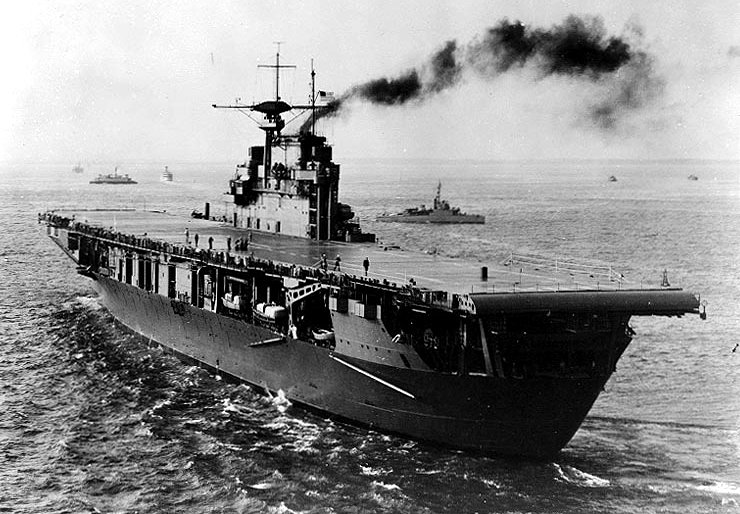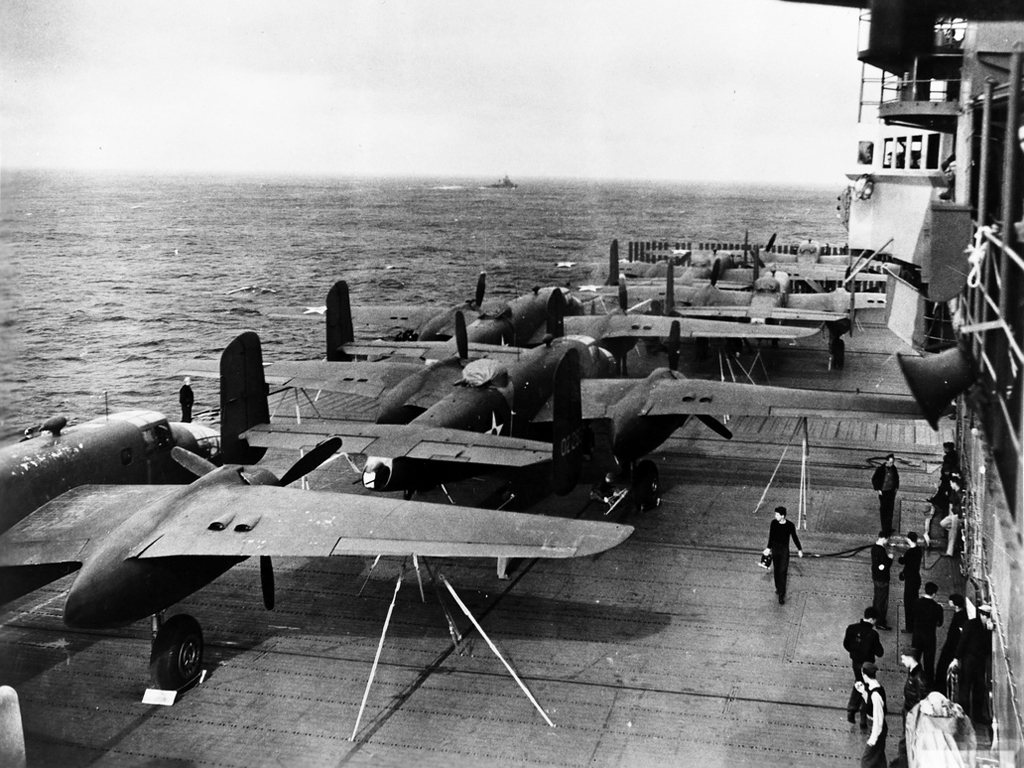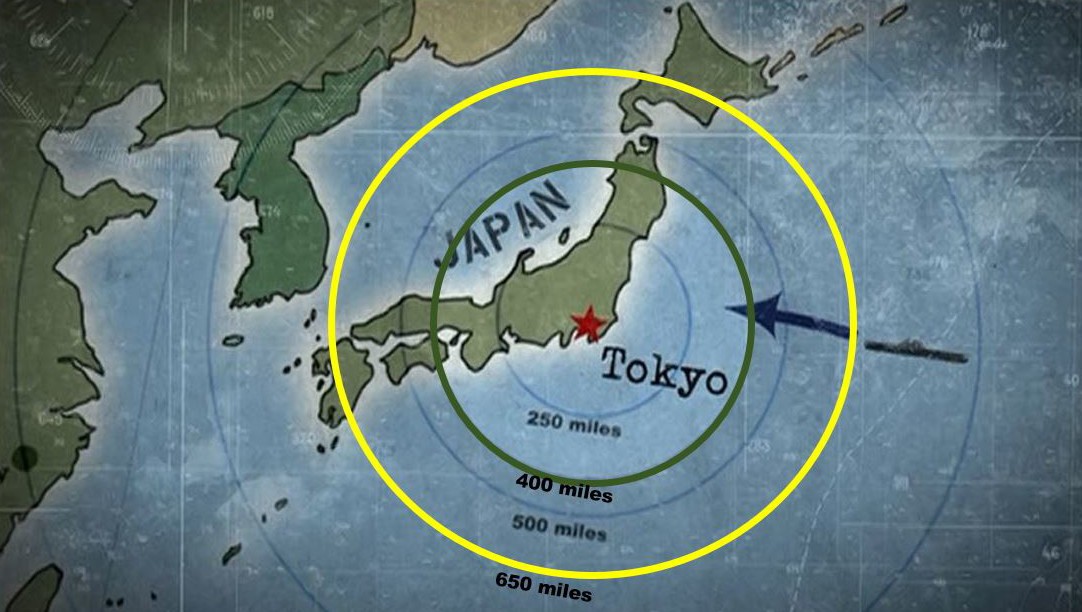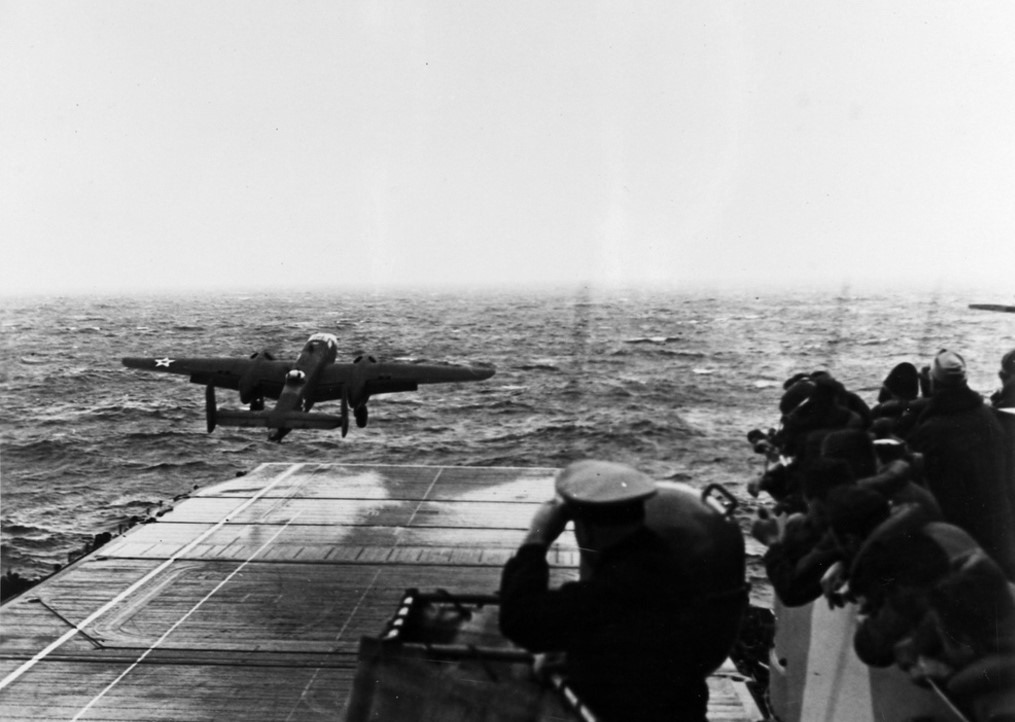This is a follow-up to the previous post, The Doolittle Raid, Part 1. For details of the actual raid, please refer to that post. To my knowledge, three diecast manufactures have produced the B-25 Mitchell in 1/72 scale — Forces of Valor, Corgi, and newcomer Air Force 1. Of these, only Corgi and Air Force 1 have liveries specifically for the Doolittle Raid, with Corgi releasing two and Air Force 1 releasing one. Forces of Valor did not release a Doolittle Raid model since their casting is of the later B-25J version of the Mitchell, rather than the B-25B used in the Doolittle Raid.
The Corgi AA35302 represents Colonel Doolittle’s plane, the “40-2344,” the first one to take off from the Hornet. The Corgi AA35312 represents the “Ruptured Duck,” the seventh bomber to take off from the Hornet. The Air Force 1 A00111 is also a model of the “40-2344,” Colonel Doolittle’s plane. While I missed the first Corgi release, I do have the second one, which is essentially identical to the first one other than the markings. Thus, this post concerns Corgi’s “Ruptured Duck” and Air Force 1’s “40-2344.”
Corgi Aviation Archive AA35312
North American B-25B Mitchell
40-2261 “Ruptured Duck,” Doolittle Raid, USS Hornet, 1942
Limited Edition (2,000 pieces)
Below are photos of the Corgi AA35312, which represents the “Ruptured Duck,” the 7th plane to take off from the Hornet. The “Ruptured Duck” was piloted by Lt. Ted Lawson, who wrote Thirty Seconds Over Tokyo, arguably the most widely-read account of the Doolittle Raid and upon which the 1944 movie of the same name was based. If you’re reading this blog, it’s a safe bet you read the book as a youngster.
The model is a beauty — casting, panel lines, finish, and markings. The opaque olive drab finish is outstanding, as is the gray camouflage on the underside of the fuselage. Note that, according to most sources, the propeller tips on the actual Doolittle B-25 Mitchells were not yellow.
The opaque olive drab finish is outstanding, as is the gray camouflage on the underside of the fuselage. Note that, according to most sources, the propeller tips on the actual Doolittle B-25 Mitchells were not yellow.  Here’s a port-side eye-level view of the ship. Note the US Army Air Force marking (the Air Force was under the Army at the time) — red disk within a five-pointed white star on a circular blue field with the shades specified for the U.S. flag — used until May 1942. The insignia was included on the fuselage on both sides aft of the wing and on the upper surface of the port wing and lower surface of the starboard wing. A curiosity of the marking is that the red “meatball” does not touch the inside angles of the star. The star, on the other hand, does go out to the edge of the blue disk, something that was later changed. These seemingly trivial details are important when dating photos.
Here’s a port-side eye-level view of the ship. Note the US Army Air Force marking (the Air Force was under the Army at the time) — red disk within a five-pointed white star on a circular blue field with the shades specified for the U.S. flag — used until May 1942. The insignia was included on the fuselage on both sides aft of the wing and on the upper surface of the port wing and lower surface of the starboard wing. A curiosity of the marking is that the red “meatball” does not touch the inside angles of the star. The star, on the other hand, does go out to the edge of the blue disk, something that was later changed. These seemingly trivial details are important when dating photos. Here’s a starboard-side eye-level view. Note that Corgi correctly removed the nose gun from this release, as the Doolittle Raiders had done on the actual bombers. Corgi had mistakenly included it in their first release.
Here’s a starboard-side eye-level view. Note that Corgi correctly removed the nose gun from this release, as the Doolittle Raiders had done on the actual bombers. Corgi had mistakenly included it in their first release. Here’s a view from the rear. Note that the Doolittle Raid bombers had a crew of five, rather than six, because the tail gunner section was removed to reduce weight and increase fuel storage space. Thus, the guns were removed from the tail cone and broomsticks were substituted in their place to deter enemy fighters from stern attacks. Corgi correctly left the tail guns — or broomsticks — in place.
Here’s a view from the rear. Note that the Doolittle Raid bombers had a crew of five, rather than six, because the tail gunner section was removed to reduce weight and increase fuel storage space. Thus, the guns were removed from the tail cone and broomsticks were substituted in their place to deter enemy fighters from stern attacks. Corgi correctly left the tail guns — or broomsticks — in place. This close-up shows the distinctive “Ruptured Duck” motif well. Amazingly, the words “Danger Propeller” can be read clearly on the vertical red warning line, which is only 1 mm wide. Note also the pilot and copilot figures. Although Corgi had included a bombardier figure on the nose of their previous B-25 releases, including their first Doolittle Raid release, Corgi inexplicably did not include one in this release, despite the fact that Corgi’s packaging clearly shows one.
This close-up shows the distinctive “Ruptured Duck” motif well. Amazingly, the words “Danger Propeller” can be read clearly on the vertical red warning line, which is only 1 mm wide. Note also the pilot and copilot figures. Although Corgi had included a bombardier figure on the nose of their previous B-25 releases, including their first Doolittle Raid release, Corgi inexplicably did not include one in this release, despite the fact that Corgi’s packaging clearly shows one. 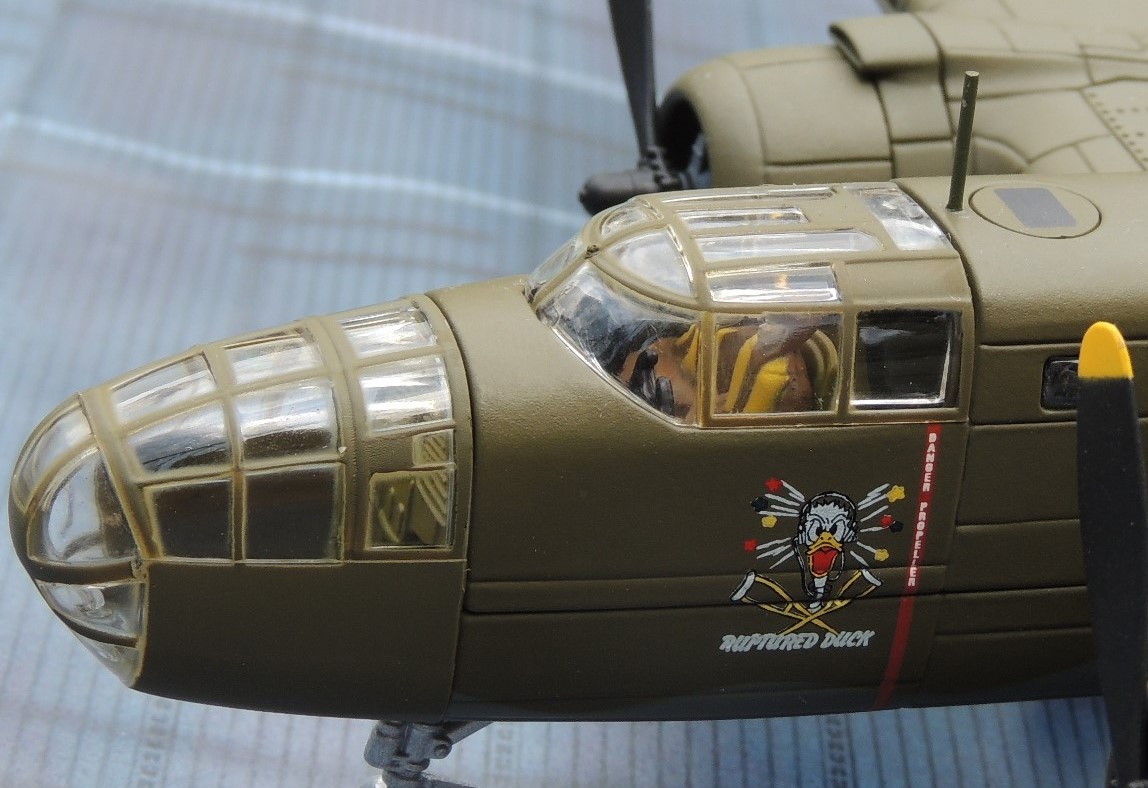 Here’s a photo of the model on its stand. Corgi provides the option of landing gear up or down. Like most of Corgi’s Limited Edition models, this piece has a numbered Collector Card.
Here’s a photo of the model on its stand. Corgi provides the option of landing gear up or down. Like most of Corgi’s Limited Edition models, this piece has a numbered Collector Card. Like other heavy Corgi models, this one sits on a cradle in an inclined take-off position.
Like other heavy Corgi models, this one sits on a cradle in an inclined take-off position. The Rub
The Rub
I would be remiss if I failed to point out an exasperating design flaw in the model: it’s hopelessly tail-heavy. The model will simply not stand on its three wheels, but instead tilts back like a stubborn donkey sitting on its haunches.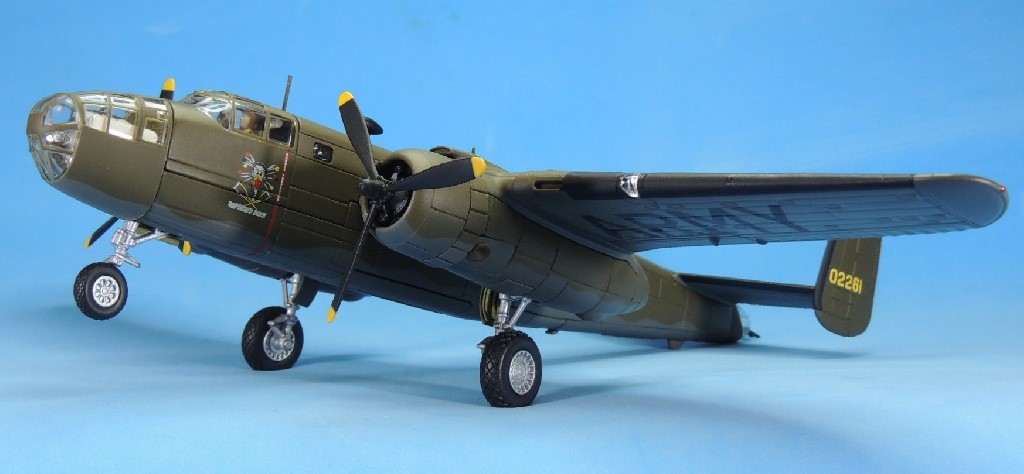 To solve the problem, I carefully removed the nose piece and increased the weight at the front by inserting the sawed-off half of an Allen wrench in the crawlway leading to the bombardier compartment. It fit perfectly, though the photo shows it protruding slightly out of the crawlway to better illustrate the placement. I then added two 1/4 ounce lead weights to the nose. The extra weight did the trick.
To solve the problem, I carefully removed the nose piece and increased the weight at the front by inserting the sawed-off half of an Allen wrench in the crawlway leading to the bombardier compartment. It fit perfectly, though the photo shows it protruding slightly out of the crawlway to better illustrate the placement. I then added two 1/4 ounce lead weights to the nose. The extra weight did the trick.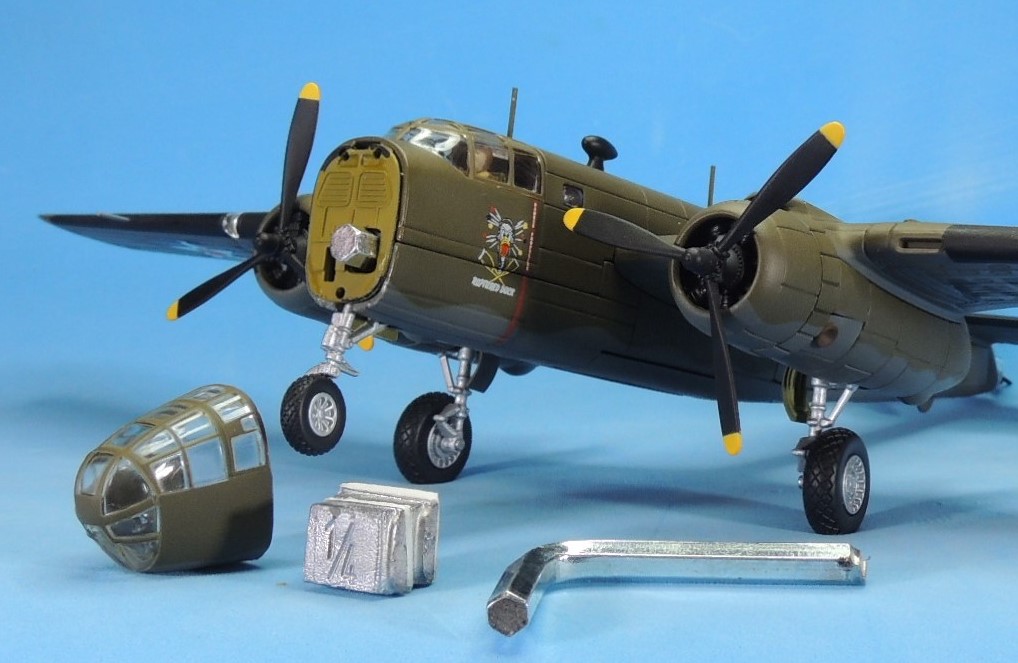 The Crew
The Crew
To personalize this model, here’s a photo of the crew of the actual “Ruptured Duck.” From left to right: Lt. Charles L. McClure, navigator; Lt. Ted W. Lawson, pilot; Lt. Robert S. Clever, bombardier; Lt. Dean Davenport, copilot; and Sgt. David Thatcher, flight engineer/gunner. 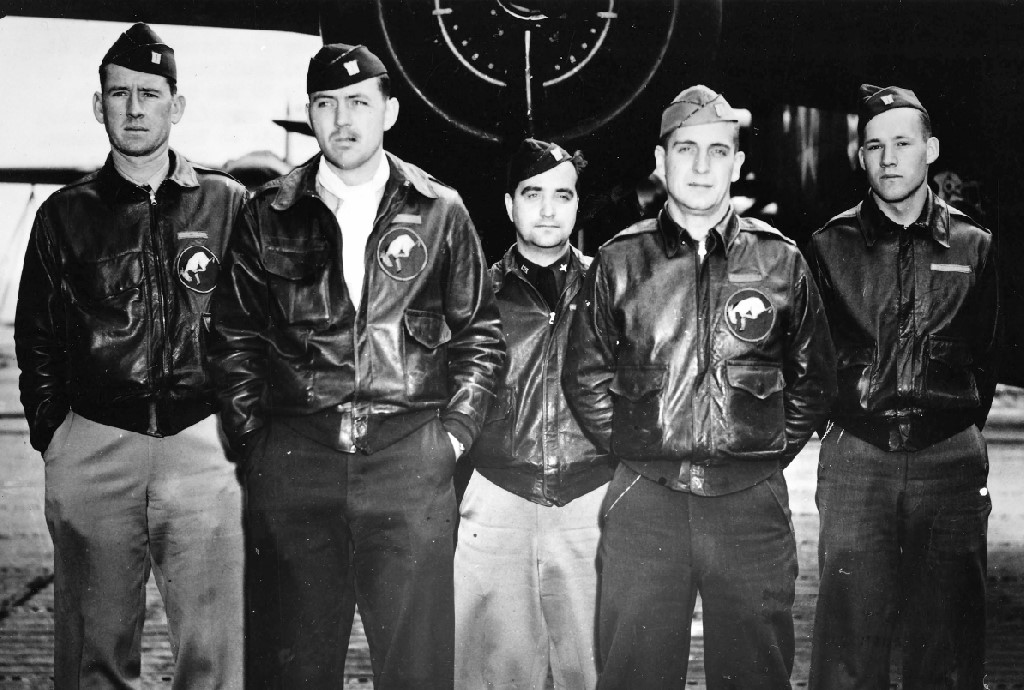 It should be noted that Lt. Ted Lawson, author of Thirty Seconds Over Tokyo, lost his left leg due to the crash landing. Sgt. David Thatcher, on the far right, is one of only two Doolittle Raiders alive today.
It should be noted that Lt. Ted Lawson, author of Thirty Seconds Over Tokyo, lost his left leg due to the crash landing. Sgt. David Thatcher, on the far right, is one of only two Doolittle Raiders alive today.
Air Force 1 A00111
North American B-25B Mitchell
40-2344, Jimmy Doolittle and Richard Cole
Limited Edition Signature Series Hand-Signed by Lt. Cole
Below are photos of the Air Force 1 A00111, which represents the “40-2344,” Colonel Doolittle’s ship and the first one to take off from the USS Hornet. The first thing one notices is that the overall olive drab finish is entirely too shiny. A coat of dullcote clear flat lacquer will be necessary for a more realistic look. Similarly, the gloss black color of the propellers makes them look too “plasticky” and will require a coat of flat black.  The casting is really not a bad effort. The panel lines and details are crisp and rivet holes are included on every panel. The casting is diminished, however, by the porthole windows, which are mere indentations in the metal that have been painted silver to simulate glass. The effect is reminiscent of windows found on hand-made wooden models. While the technique works on wooden models, since all windows on a model are represented in the same fashion, the contrast between the simulated glass of the porthole windows and the clear plastic of the nose and cockpit glass on this model is too distracting.
The casting is really not a bad effort. The panel lines and details are crisp and rivet holes are included on every panel. The casting is diminished, however, by the porthole windows, which are mere indentations in the metal that have been painted silver to simulate glass. The effect is reminiscent of windows found on hand-made wooden models. While the technique works on wooden models, since all windows on a model are represented in the same fashion, the contrast between the simulated glass of the porthole windows and the clear plastic of the nose and cockpit glass on this model is too distracting.
 Air Force 1 correctly did not paint the propeller tips yellow, a mistake made by Corgi. Unlike the Corgi model, the Air Force 1 does not have pilot or copilot figures.
Air Force 1 correctly did not paint the propeller tips yellow, a mistake made by Corgi. Unlike the Corgi model, the Air Force 1 does not have pilot or copilot figures.  Like the actual B-25 Mitchell it’s based on, the model has no individual markings or artwork other than the “02344” tail number. Note that Air Force 1 did not include the words “DANGER PROPELLER” on the vertical red warning lines that mark the propeller line, a detail that stands out on the Corgi.
Like the actual B-25 Mitchell it’s based on, the model has no individual markings or artwork other than the “02344” tail number. Note that Air Force 1 did not include the words “DANGER PROPELLER” on the vertical red warning lines that mark the propeller line, a detail that stands out on the Corgi.
 The dorsal gun turret appears to have a “sloped” front, rather than a rounded one. See a comparison of the turrets in the next section below. The turret rotates but, unlike the Corgi model, the guns are fixed in place and do not elevate.
The dorsal gun turret appears to have a “sloped” front, rather than a rounded one. See a comparison of the turrets in the next section below. The turret rotates but, unlike the Corgi model, the guns are fixed in place and do not elevate.  The model sits on a sturdy all-metal display stand. Unlike the Corgi model, which has separate wheels to provide wheels up or down options, the Air Force 1 model has fixed landing gear so there is no wheels up option. Note the limited edition metal plaque with Lt. Richard Cole’s signature. One wonders how “limited” the edition really is, as Air Force 1 did not provide an edition number.
The model sits on a sturdy all-metal display stand. Unlike the Corgi model, which has separate wheels to provide wheels up or down options, the Air Force 1 model has fixed landing gear so there is no wheels up option. Note the limited edition metal plaque with Lt. Richard Cole’s signature. One wonders how “limited” the edition really is, as Air Force 1 did not provide an edition number.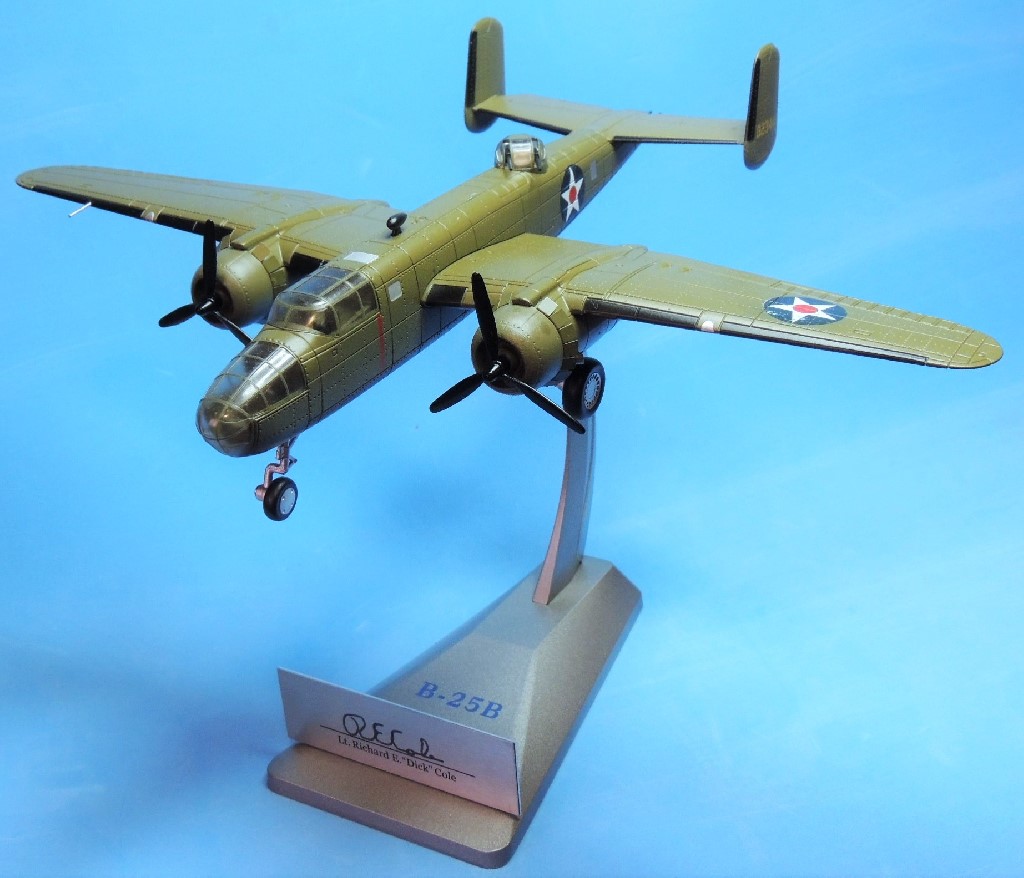 The model sits horizontally on its stand, unlike the Corgi model, which is sits at an inclined angle.
The model sits horizontally on its stand, unlike the Corgi model, which is sits at an inclined angle.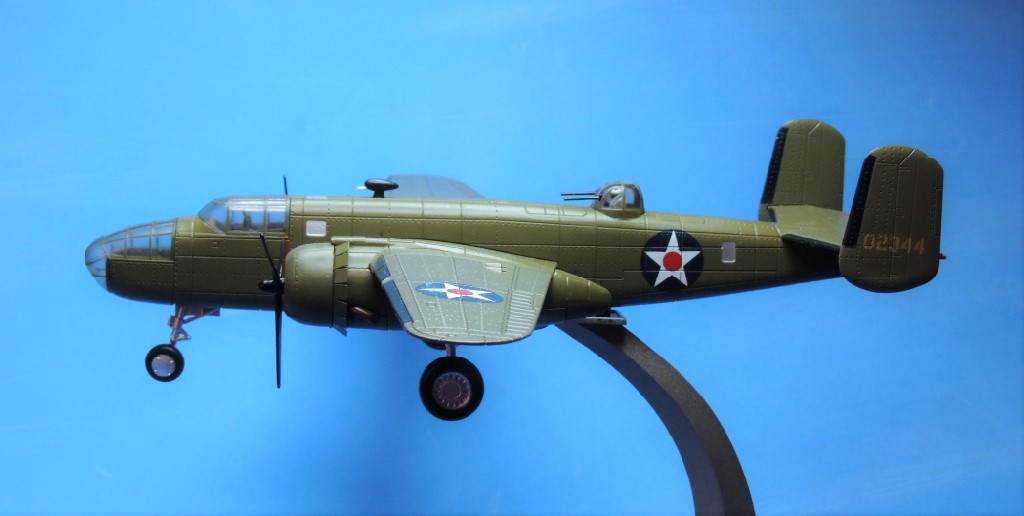 The Rub
The Rub
Many collectors were disappointed in Air Force 1’s turret, noting that it appeared too tall or oversized. I think it’s neither. Instead, Air Force 1 used the wrong turret — one with a sloped front that I believe was used on later versions of the B-25 Mitchell, such as the B-25J. I would appreciate confirmation from any reader.
The Crew
Once again, to personalize the model, here’s a photo of Doolittle’s crew. From left to right, Lt. Henry A. Potter, navigator; Lt. Col. James H. Doolittle, pilot; SSgt. Fred A. Braemer, bombardier; Lt. Richard E. Cole, copilot; and SSgt. Paul J. Leonard, flight engineer/gunner. 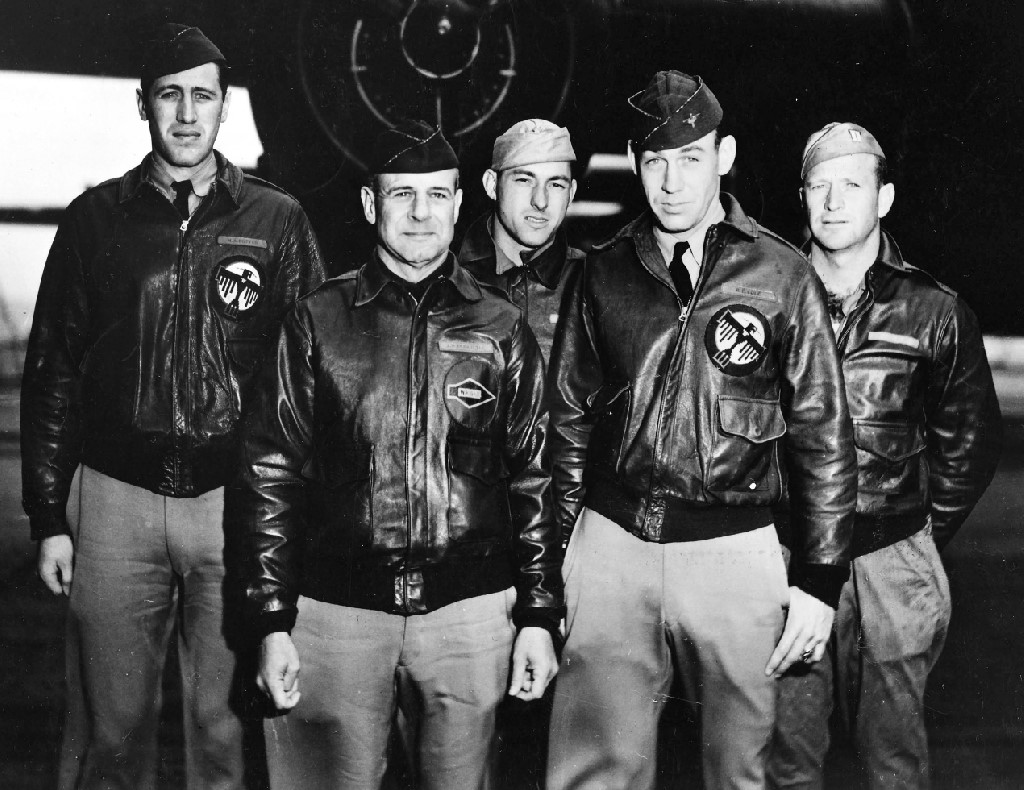 In addition to Sgt. David Thatcher, pictured under the Corgi section above, Lt. Richard Cole, second from right, is the only other Doolittle Raider alive today.
In addition to Sgt. David Thatcher, pictured under the Corgi section above, Lt. Richard Cole, second from right, is the only other Doolittle Raider alive today.
Side-by-Side Comparison
Finally, here are some side-by-side shots. Note the superb riveting on the Air Force 1 (left) on every single panel. On the other hand, note the simulated porthole windows on that same model, which, at least to me, blemish the entire effort.
 Note the stark difference in the finish, with the Air Force 1 (left) having a distracting shine. Despite the apparent difference in size in the photos, the two models are identical in their dimensions. The difference in the photos is a result of using a close-up lens, which exaggerates perspective.
Note the stark difference in the finish, with the Air Force 1 (left) having a distracting shine. Despite the apparent difference in size in the photos, the two models are identical in their dimensions. The difference in the photos is a result of using a close-up lens, which exaggerates perspective.  Here’s a photo of the starboard side. Note the difference in the placement of deicing boots (the black surfaces on the leading edge of the wings). As far as I can tell, Air Force 1’s depiction is correct.
Here’s a photo of the starboard side. Note the difference in the placement of deicing boots (the black surfaces on the leading edge of the wings). As far as I can tell, Air Force 1’s depiction is correct.  The Upshot
The Upshot
This being a comparison review, the reader will naturally wonder which of the two models is recommended. Let’s compare the various features:
- Casting: Both castings are excellent, with crisp detail throughout, though I was impressed with the rivets on every panel of the Air Force 1, even if they may be slightly overscaled. However, the simulated porthole windows detract from the casting.
- Finish: No contest, the Corgi’s opaque olive drab finish is superb, resulting in a realistic model. The shiny finish on the Air Force 1, on the other hand, will need dulling. Both have gray camouflage on the underside of the fuselage but the Corgi’s is more undulating, and more realistic. The propellers on the Air Force 1 are also noticeably shiny and look plasticky.
- Markings: I’m a sucker for art on a model and the well-documented “Ruptured Duck” design on the Corgi is fabulous. It’s an unfair comparison, I concede, since Doolittle’s ship carried no art. However, beyond the insignia, Corgi’s attention to detail is evident in including a warning on the vertical red propeller warning line, which, truly, is only 1 mm wide.
- Detail Accuracy: The sloped turret on the Air Force 1 appears to be that used on later B-25 Mitchells and is wrong. The Corgi’s appears to be accurate. The deicing boots and the absence of yellow tips on the propellers on the Air Force 1 are correct, though these are details that can be easily corrected on the Corgi.
- Engineering Design: The tail-heavy design of the Corgi is exasperating and makes you wonder how Corgi could bungle a feature that they had previously done properly. The Air Force 1 stands on its three wheels, as it should.
- Extras: The Corgi model includes pilot and copilot figures, which is always a welcome feature. Inexplicably, however, it does not have a bombardier, unlike previous Corgi B-25 releases, including their first Doolittle release. On the plus side for Air Force 1, I love having Lt. Cole’s signature. It’s as close as I’ll get to such an historic event.
While both models are excellent replicas of the B-25 Mitchell, the Corgi version is clearly superior but, given that it cost twice as much as the Air Force 1, it ought to be. It is not, however, twice as good as the Air Force 1. Thus, in my view, the Air Force 1 is a great value, particularly as the two Corgi models disappeared into collectors’ homes and are now difficult to find. Still, both models are worthy of any collection, if for no other reason than they represent an important event in World War II.
Again, thank you for your indulgence and I hope you enjoyed the post. As always, comments, questions, observations, and corrections are welcome. Stay tuned next week for Part 3, a simple diorama of a B-25 Mitchell taking off from the deck of the Hornet.
—————————————————————————————————————————-
I want to thank and remember my dear friend and fellow WWII buff David C. Brooks, who passed away in 2014. As a token of our friendship, David kindly gave me his childhood copy of Thirty Seconds Over Tokyo in 2002, while we were serving in Nicaragua. Here’s a lagniappe photo for my dear friend.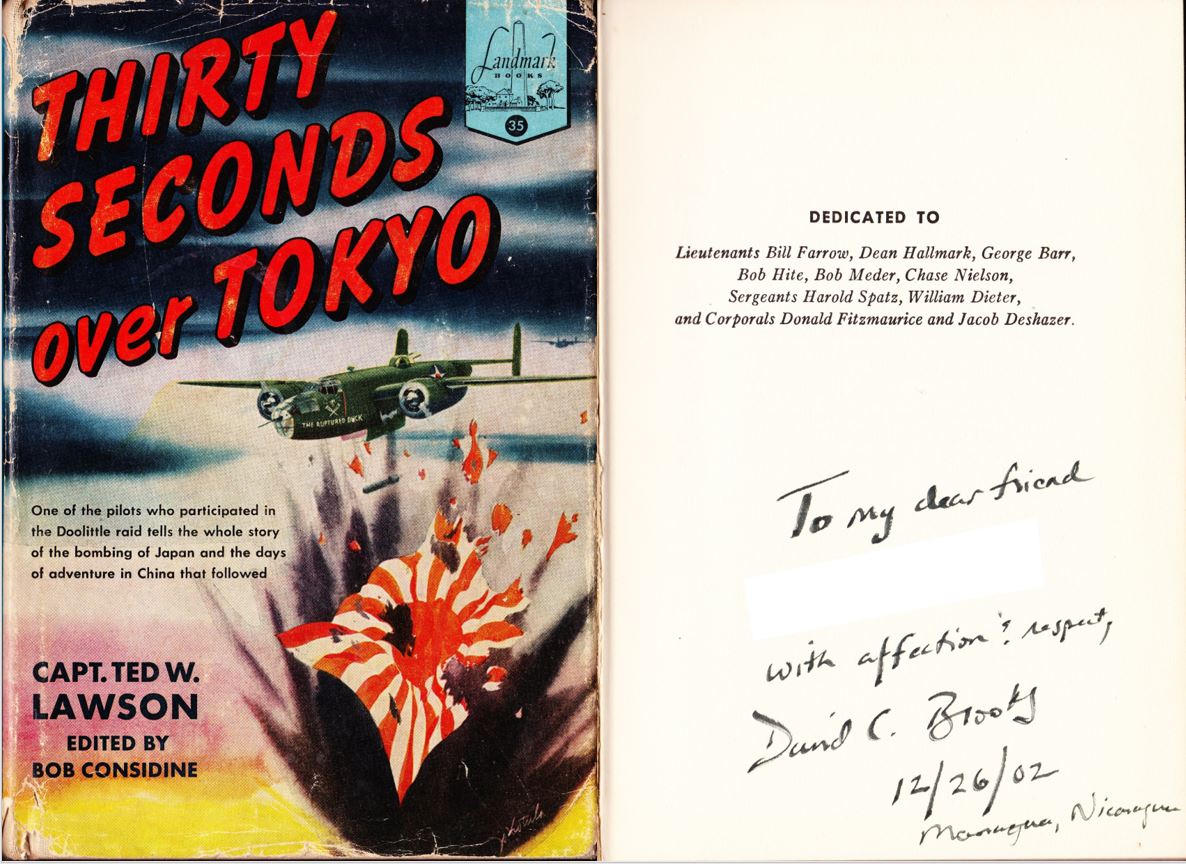
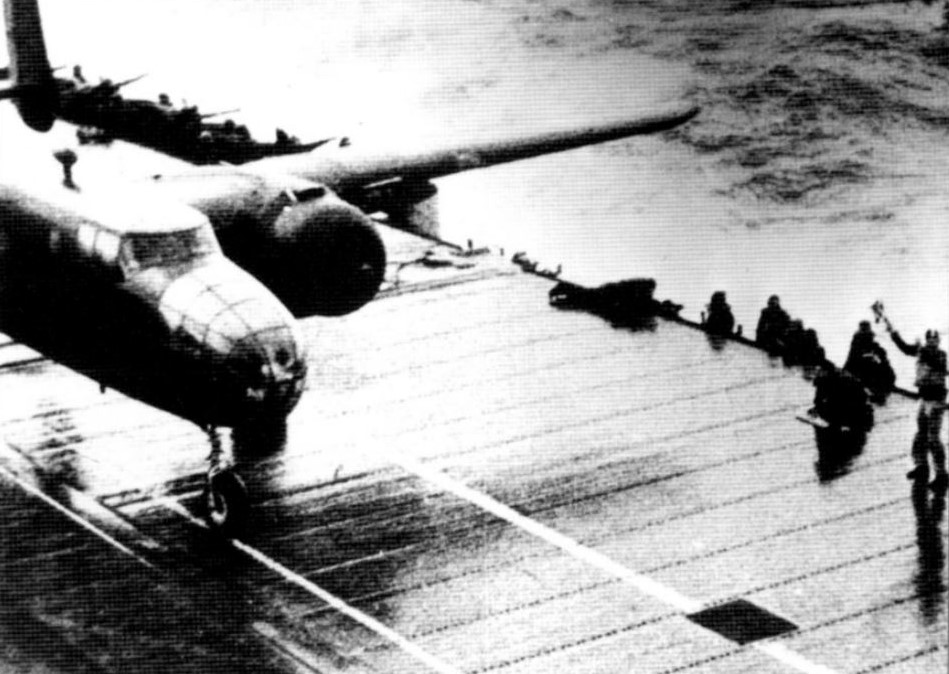 Here’s a 1/72 scale recreation. As always with these diorama photos, there is no photoshopping. It’s one of my self-imposed constraints.
Here’s a 1/72 scale recreation. As always with these diorama photos, there is no photoshopping. It’s one of my self-imposed constraints.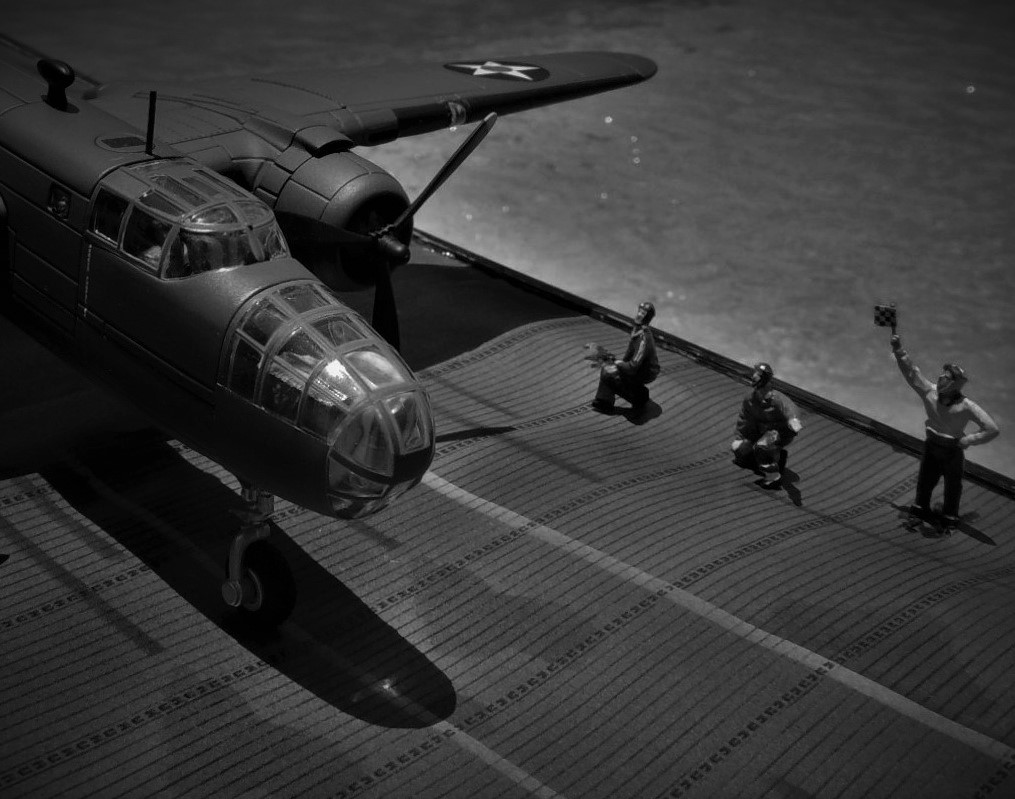 Here’s the same photo in full color.
Here’s the same photo in full color.  The model is the Corgi AA35312 B-25B Mitchell “Ruptured Duck,” flown by Lt. Ted Lawson, author of Thirty Seconds Over Tokyo. For a review of this model, see the previous post.
The model is the Corgi AA35312 B-25B Mitchell “Ruptured Duck,” flown by Lt. Ted Lawson, author of Thirty Seconds Over Tokyo. For a review of this model, see the previous post.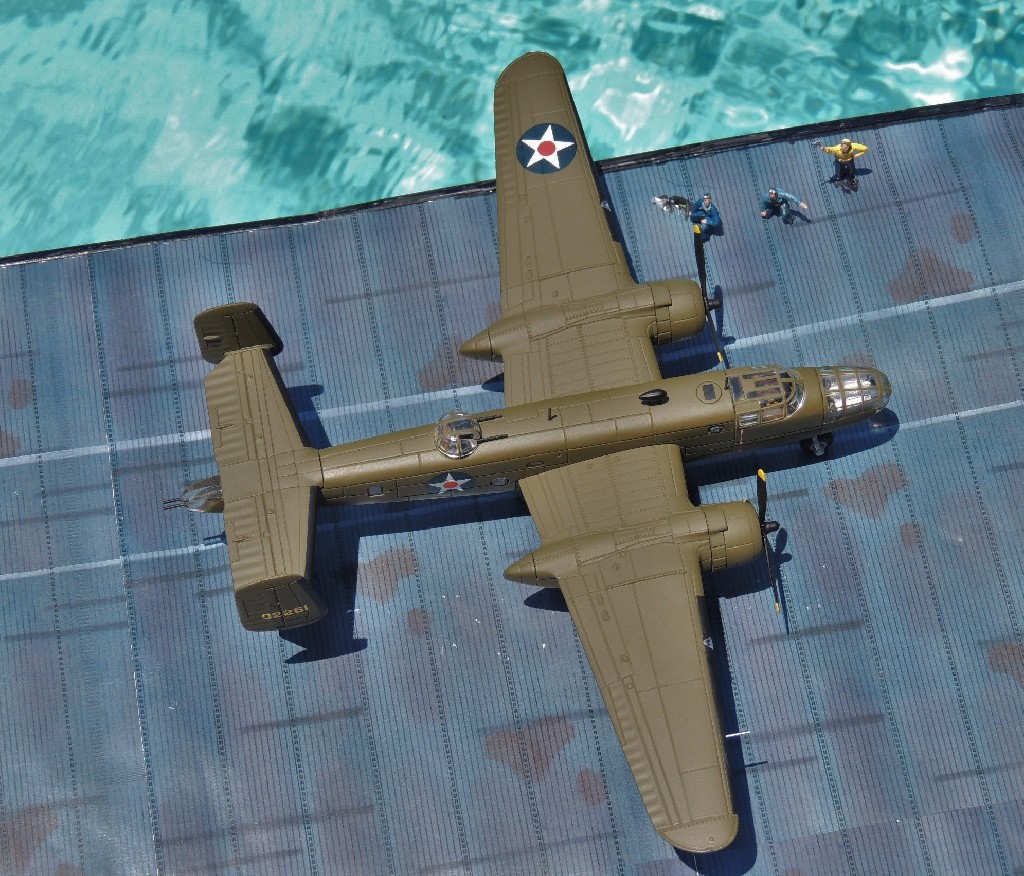 The figures are from the Corgi US61005 F4U-1D Corsair. I made the checkered flag from cardboard and added it to the signal officer to match the original photo. It’s 1/4 the size of Lincoln’s head on a penny.
The figures are from the Corgi US61005 F4U-1D Corsair. I made the checkered flag from cardboard and added it to the signal officer to match the original photo. It’s 1/4 the size of Lincoln’s head on a penny. I built a section of the USS Hornet’s deck on a large styrofoam base using a scanned copy of the 8″x8″ aircraft carrier deck base included in the Corgi US61005 F4U-1D Corsair. After scanning the Corgi base, I reproduced it a dozen times and then combined the scans with graphics software to make a larger deck, ensuring the plank segments matched. The only difficulty was in blending in the white guidelines. I then printed the entire deck section on paper and glued it to the styrofoam base. Unfortunately, being made of paper, the miserable thing warped from the glue. I was so focused on the plane when taking the photos that I failed to notice the warping until I was cropping the photos. Rats!
I built a section of the USS Hornet’s deck on a large styrofoam base using a scanned copy of the 8″x8″ aircraft carrier deck base included in the Corgi US61005 F4U-1D Corsair. After scanning the Corgi base, I reproduced it a dozen times and then combined the scans with graphics software to make a larger deck, ensuring the plank segments matched. The only difficulty was in blending in the white guidelines. I then printed the entire deck section on paper and glued it to the styrofoam base. Unfortunately, being made of paper, the miserable thing warped from the glue. I was so focused on the plane when taking the photos that I failed to notice the warping until I was cropping the photos. Rats!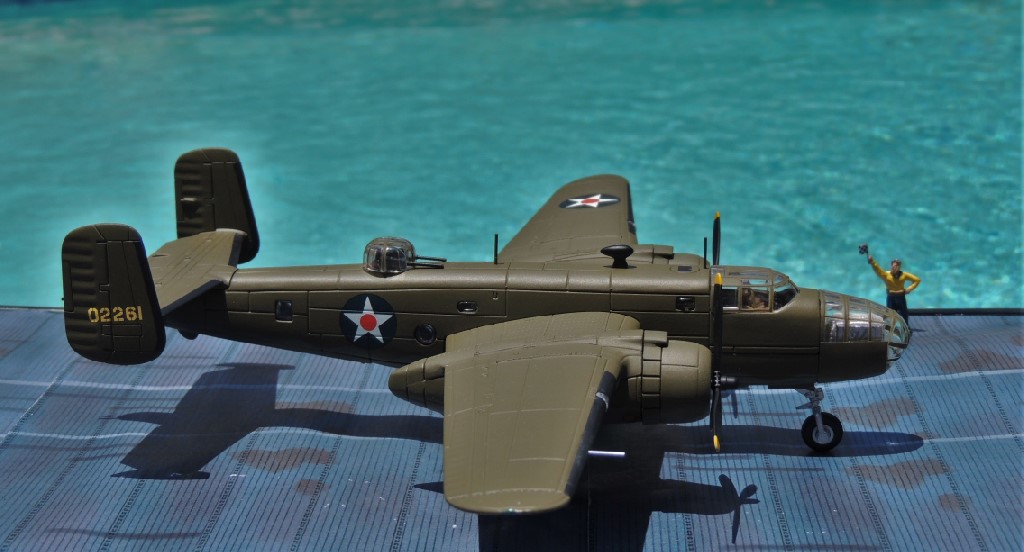 I photographed the scene by the side of the swimming pool next to one of the pool jets to ensure some “turbulence,” such as it is. The result exceeded my expectations, something entirely too rare.
I photographed the scene by the side of the swimming pool next to one of the pool jets to ensure some “turbulence,” such as it is. The result exceeded my expectations, something entirely too rare.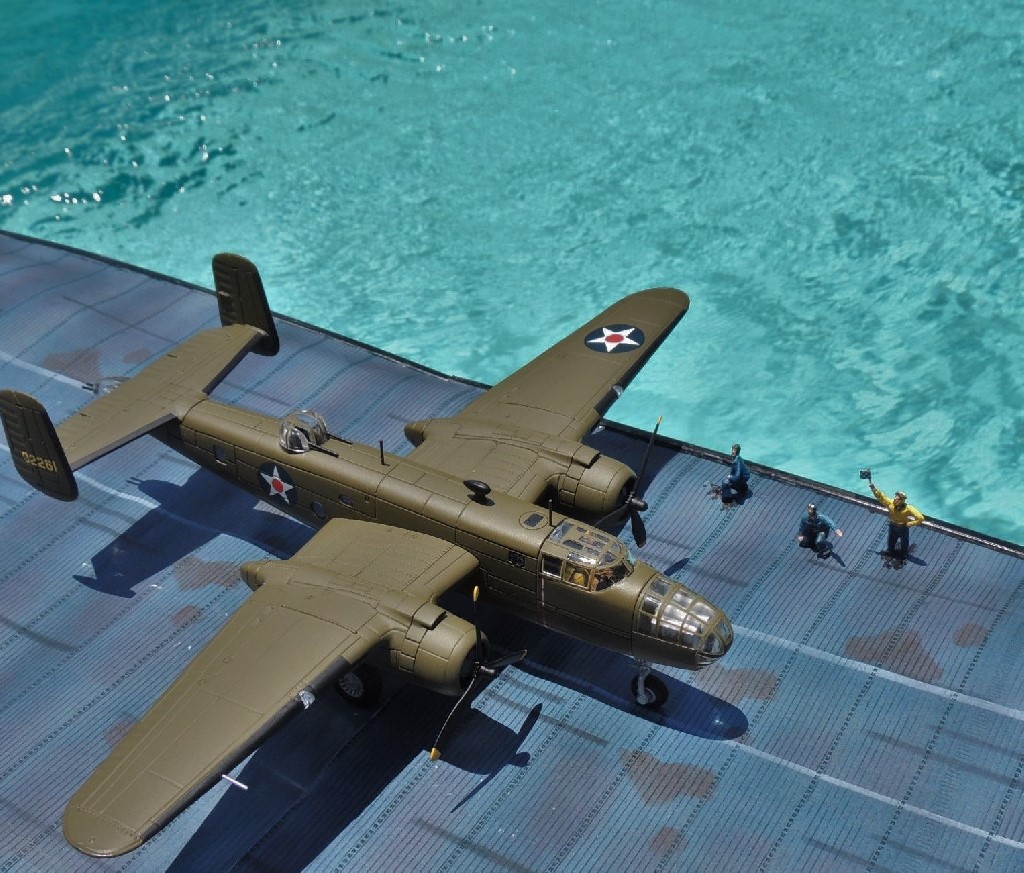 Here’s a view from the front. Note the two white lines on the deck that the pilots used as guides. The different widths of the lines and the distance between them and the edge of the deck are at scale. The propellers turn freely and I considered placing a fan in front of them for a spinning effect as I took the photo. Alas, I managed to resist the urge. Compulsive personalities will likely relate to the comment.
Here’s a view from the front. Note the two white lines on the deck that the pilots used as guides. The different widths of the lines and the distance between them and the edge of the deck are at scale. The propellers turn freely and I considered placing a fan in front of them for a spinning effect as I took the photo. Alas, I managed to resist the urge. Compulsive personalities will likely relate to the comment. 
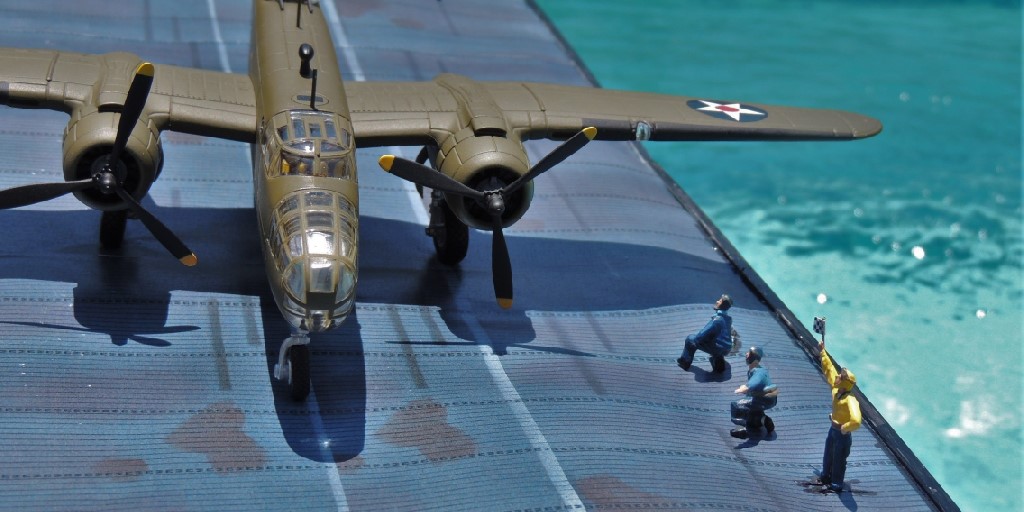 Here’s a lagniappe photo of a B-25 Mitchell taking off from the USS Hornet. I captured it from a widely available newsreel clip of one of the B-25 Mitchells taking off. Note the flag used by the signal officer — clearly a 4×4 checkered flag. Again, note the choppy waters. The take-off runs for the Doolittle Raid were timed to coincide with the B-25 Mitchells reaching the Hornet’s bow when it was at its high point on a swell, rather than its low point on a trough, thus assisting with the take-off.
Here’s a lagniappe photo of a B-25 Mitchell taking off from the USS Hornet. I captured it from a widely available newsreel clip of one of the B-25 Mitchells taking off. Note the flag used by the signal officer — clearly a 4×4 checkered flag. Again, note the choppy waters. The take-off runs for the Doolittle Raid were timed to coincide with the B-25 Mitchells reaching the Hornet’s bow when it was at its high point on a swell, rather than its low point on a trough, thus assisting with the take-off.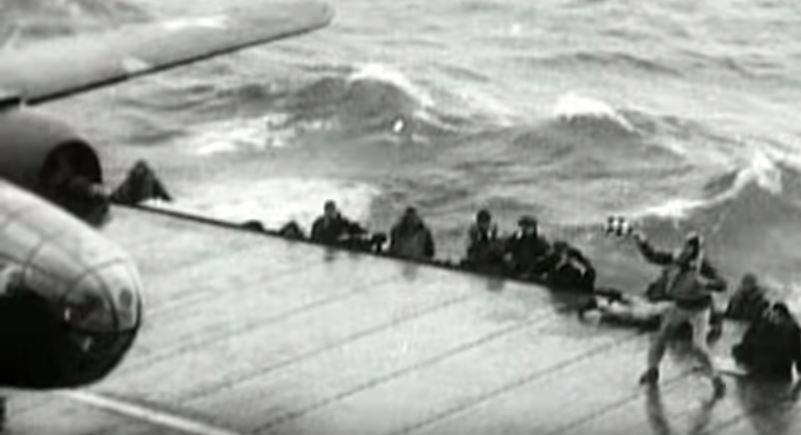 I hope you enjoyed this simple diorama. As always, comments, questions, corrections, and observations are welcome. Stay tuned next week for Part 4, regarding potential Doolittle Raid liveries for consideration by diecast manufacturers.
I hope you enjoyed this simple diorama. As always, comments, questions, corrections, and observations are welcome. Stay tuned next week for Part 4, regarding potential Doolittle Raid liveries for consideration by diecast manufacturers.
























